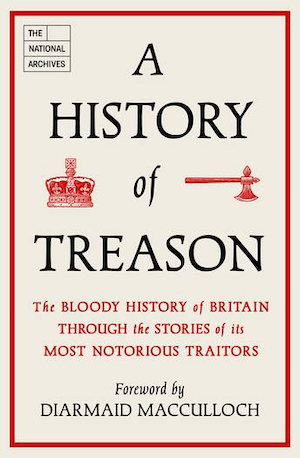By Allen D. Boyer
“England is the ‘mother of parliaments,’” the authors of this history warn. “It is equally the mother of treasons.” Across chapters that narrate conspiracies, betrayals, and crackdowns, that insight runs as true as a surveyor’s line, for the authors eloquently argue that to chart the history of British treason is to map out their nation’s constitutional history.
The English word traitor comes from the Romans: from traditor, one who hands something over. The definition of treason took shape seven centuries ago, when the Middle English word tresun acquired the meaning of proditor, one who betrays the ruler or state. The reigns of two kings serve as prologue. Edward I was an able ruler, but choleric and ruthless. He executed “over twenty of his enemies for treason, often involving himself in proceedings at a deep personal level, and in processes of dubious legality.” In the reign of his son Edward II, earls and courtiers traded broad accusations of treason, in a bloody struggle that ended with the king’s own overthrow and death.
Edward III gave high treason the clarity of written law. This came in the Great Statute of Treasons, enacted in 1352. In its central passages, the Great Statute declared that it was treason ‘’when a man doth compass or imagine the Death of our Lord the King,” or “if a Man do levy War against our Lord the King in his Realm or be adherent to the King’s Enemies in his Realm, giving to them Aid and Comfort.”
That language echoes in the Constitution of the United States. And, however worn, battered, and shifted by the centuries, the core of the Great Statute remains in effect today.
The United States, whose Founding Fathers represent “Britain’s most successful traitors,” finds a place in this narrative. So too do Ireland, and the ideals of the French Revolution, and the lunatics who fired pistols at Queen Victoria.
This book also explores lesser-known American revolutions. On the island of Grenada, in 1796, British authorities faced a four-sided political conflagration: a revolt by French-speaking planters and English-speaking slaves, which the colonial authorities suppressed by enlisting their own slave militia, the Loyal Black Rangers. London’s plans to “ameliorate” slavery, with a vague goal of full emancipation, led to a full-scale slave revolt on Jamaica in 1832.
For rebels, rebellion has been a way of conceiving escape from misrule. “All treasons are an exercise in the counterfactual, imagining a new, changed state.” Rulers, however, have used treason “to mark people and ideas that were incompatible with the constitution and dangerous to the body politic.” Throughout English history, whenever the meaning of treason has drastically expanded, the authors find that “the potential dangers of tyranny have emerged . . . . When treason becomes too broad, it loses its purpose, becoming instead sheer brutality.”
“The last execution for treason was within living memory,” Diarmaid MacCulloch cautions in his introduction. That was William Joyce, hanged in January 1946. Joyce’s case was dubious. There was no doubt that he was a member of the British Union of Fascists and had spent the war making propaganda broadcasts for Hitler. However, Joyce was not a British subject; he was Irish by blood and American by birth. His only link to Britain was a British passport that he had wrongfully obtained. The judge ruled that holding a British passport meant that Joyce owed loyalty to the British crown. This was a tenuous connection, but it allowed the jury to find him guilty.
To employ the Great Statute requires making such treacherous judgments. For that reason, most modern-day prosecutions have been brought under the Treachery Act of 1940 or the Official Secrets Act, laws which focus on concrete actions rather than theoretical loyalties. And yet, there remains a curious strength in the medieval statute.
“The Treason Act of 1352 . . . still holds a huge emotional, historical, and legal weight. Like Magna Carta and the Bill of Rights, it has entered the pantheon of talismanic documents which define the unwritten British constitution. It persists as a reminder that there have always been laws to protect the sovereign and the state.”
Issued by the British National Archives, this study is the work of Chris Day, Daniel Gosling, Neil Johnston, and Euan Roger — veteran archivists and scholars. They have produced a learned, lucid, timely book.
Allen D. Boyer (ΦBK, Vanderbilt University, 1977), is a writer and historian in New York City. Vanderbilt University is home to the Alpha of Tennessee Chapter of Phi Beta Kappa.




